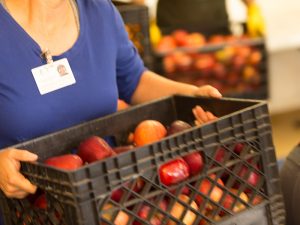Food is Medicine
At Mercy Brown Bag, w e provide our recipients with 20lb bags of food twice a month. Here is the breakdown of one of our bags..
e provide our recipients with 20lb bags of food twice a month. Here is the breakdown of one of our bags..
Fresh Produce and Fruit (53%)
- Items can include salad mix, potatoes, yams, onions, strawberries, apples, oranges, carrots, cabbage, squash, pears, plums, cauliflower, celery, brussel sprouts and more…
Canned/Frozen Foods (12%)
- Items can include mixed vegetables, fruit, soups, sauces, beans, and more…
Grains/Fiber-Rich Foods (12%)
- Items can include cereal, pasta, rice, crackers, oats, bread, and more…
Protein Items (13%)
- Items can include peanut butter, tuna, tilapia, eggs, beans, chicken, tofu, turkey, pork, and more…
Dairy Products: (10%)
- Items can include milk, yogurt, cheese, and more…
We believe that food is medicine. Below is an article explaining in more detail the health benefits of particular foods and how they help seniors as they age.
Got a Minute?: Nutrition needs change with age
Nutritional needs change over time. Newborns and 90 year olds are not the same.
While fruits and veggies, whole grains and lean proteins are a great idea over the course of one’s life, there are times when a little more of this or that may improve our health. During the last few decades, research has proven that particular antioxidants, nutrients and fats may be particularly beneficial as we age.
The Academy of Nutrition and Dietetics devotes a whole section of its website to senior nutrition and health. They cite several studies that indicate nutrition plays a key role in memory, vision and wound healing.
The Academy suggests adding the following foods to your refrigerator and pantry rotation in order to strengthen these areas:
Memory
■ Eat your veggies. Getting adequate vegetables, especially cruciferous ones including broccoli, cabbage and dark leafy greens, may help improve memory.
Be sweet on berries and cherries. Berries — especially dark ones such as blackberries, blueberries and cherries — are a rich source of anthocyanins and other flavonoids that may boost memory function. Enjoy a handful of fresh, frozen, or dried berries for a snack, mixed into cereal or baked into an antioxidant-rich dessert.
Get adequate omega-3 fatty acids. Essential for good brain health, omega-3 fatty acids, docosahexaenoic acid, or DHA, in particular, may help improve memory. Seafood, algae and fatty fish — including salmon, bluefin tuna, sardines and herring — are some of the best sources of omega-3 fatty acids. Substitute fish for meat a couple times each week to get a healthy dose.
Work in walnuts. Well known for a positive affect on heart health, walnuts also may improve cognitive function. Snack on a handful of walnuts to satisfy midday hunger, add them to oatmeal or a salad for crunch or mix them into a vegetable stir-fry for extra protein.
Vision
Kale, see the light: This leafy green is a rich source of lutein and zeaxanthin. Both are related to vitamin A and beta carotene, and are believed to protect eye tissues from sunlight damage and reduce the risk of cataracts and macular degeneration.
Other good sources of these nutrients include dark green leafy vegetables such as collard greens, turnip greens and spinach, broccoli, peas, kiwi, red grapes, yellow squash, oranges, corn, mangoes and honeydew melon.
Your body needs fat to absorb lutein and zeaxanthin, so be sure to eat them with a bit of healthy fat such as a drizzle of olive oil.
Sweet Potatoes, the color of health: These orange tubers are a good source of beta carotene, which may slow progress of macular degeneration. Your body converts beta carotene to vitamin A, a nutrient that helps prevent dry eyes and night blindness. Beta carotene and vitamin A also help reduce the risk of eye infections.
Other beta carotene rich foods include carrots and butternut squash, plus dark green foods including spinach and collard greens.
Strawberries, help you “C” better: Fresh, juicy strawberries are a good thing for your eyes and contain plenty of vitamin C, which is an antioxidant that can help lower your risk of cataracts.
Also, be sure to load up your plate with other vitamin C-rich foods including bell peppers, broccoli, citrus (such as orange and grapefruit) and cantaloupe.
Salmon, goodbye, dry eyes: Dry eyes? Eating enough omega-3 fatty acids can help alleviate the problem. Get some healthy fats every day in the form of salmon or other types of fish (two to three times per week), walnuts (which also contain eye-healthy vitamin E), flax and chia seeds.
Salmon also is a good source of vitamin D, which helps protect against macular degeneration. You can also get vitamin D by downing sardines, mackerel, milk and orange juice fortified with vitamin D.
Green Tea, an antioxidant powerhouse: The antioxidants in green tea may help lower risk of developing cataracts and macular degeneration. Green tea contains healthful substances called catcehins, which are responsible for its anti-inflammatory and antioxidant properties.
Other foods that are that are high in catechins include red wine, chocolate, berries and apples. Black tea also boasts catechins, but in lower amounts than its green cousin.
Wound healing
Get enough calories. The first priority is to eat sufficient calories from a balanced diet of nutritious foods. Plan healthy, balanced meals and snacks that include plenty of foods from all the food groups — protein, fruits, vegetables, dairy and grains.
Optimum protein. Include optimum amounts of protein. Aim for 20 to 30 grams of protein at each meal and 10 to 15 grams of protein with each snack. A piece of cooked chicken, lean meat or fish the size of a deck of cards (about 3 ounces) contains 20 to 25 grams of protein. One egg, 1 tablespoon of peanut butter and 1 ounce of cheese each contain 6 to 7 grams of protein. One cup of low-fat milk or yogurt contains 8 grams of protein.
Drink plenty. Stay well hydrated with water and other unsweetened beverages such as tea, coffee, 100-percent fruit juice and milk, which also contains protein.
Talk with your doctor. Some wounds may require a higher intake of certain vitamins and minerals. For people with diabetes, controlling blood sugar levels is one of the best ways to prevent and treat a wound. Work with your physician and registered dietitian nutritionist to develop a personalized blood sugar management plan.
Lorraine Wichtowski is a community health educator at UR Medicine Noyes Health in Dansville. To suggest future article topics or to discuss this article, email [email protected] or call (585) 335-4327.

